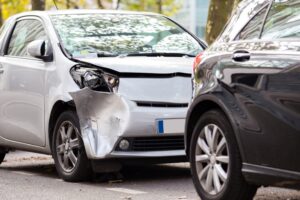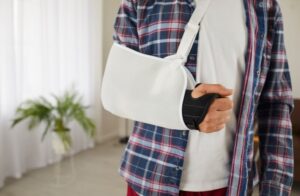If you've suffered an injury in a car accident, one of the most important things you can do is contact an experienced car accident lawyer ASAP. A knowledgeable attorney can review the details of your crash and help determine if you may be entitled to compensation for medical bills, lost income, pain and suffering, and other damages. When evaluating an auto collision, Phoenix car accident lawyers and insurance companies often refer to the "three-second rule" or "six-second rule." But what exactly does this mean?
The Basics of the Three-Second Rule
 The three-second rule suggests that drivers leave 3 seconds of space between their vehicle and the car in front of them. This buffer gives a driver enough time to perceive a hazard and react safely without rear-ending the leading vehicle if the front driver brakes suddenly.
To estimate a three-second gap, pick a fixed point that the car ahead will pass, like a road sign or marking. When their rear bumper crosses that point, slowly count "one thousand, two one thousand, three one thousand." If you reach the same fixed point before finishing the count, you follow too closely and should drop back to open up a larger gap. Remember, three seconds is the minimum recommended following distance in ideal conditions.
The three-second rule suggests that drivers leave 3 seconds of space between their vehicle and the car in front of them. This buffer gives a driver enough time to perceive a hazard and react safely without rear-ending the leading vehicle if the front driver brakes suddenly.
To estimate a three-second gap, pick a fixed point that the car ahead will pass, like a road sign or marking. When their rear bumper crosses that point, slowly count "one thousand, two one thousand, three one thousand." If you reach the same fixed point before finishing the count, you follow too closely and should drop back to open up a larger gap. Remember, three seconds is the minimum recommended following distance in ideal conditions.
Why Three Seconds of Space is Important
Maintaining a three-second gap is important because it takes the average driver about 1.5 seconds to spot a road hazard and move their foot from the gas pedal to the brake pedal. This 1.5-second "perception-reaction time" is followed by the braking time needed to stop the vehicle safely. The braking distance depends on the vehicle's speed, weight, brakes, and road conditions. But in general, at highway speeds of 65 mph, about 4.5 seconds total (1.5 seconds perception-reaction time plus three seconds braking time) is needed to stop safely. Professionals advise maintaining a minimum three-second gap to give drivers enough perception and stopping time.Extending to the Six-Second Rule
While three seconds is the minimum gap recommended in normal conditions, the "six-second rule" extends that following distance to six seconds in specific scenarios:- Inclement weather like rain, snow, fog, or ice
- Driving at night or in low visibility
- Towing a trailer or driving a larger vehicle
- Driving behind motorcycles
- Following vehicles with obscured brake lights
- In heavy, stop-and-go traffic
How Does the 3/6 Second Rule Relate to Car Accident Fault?
If you're involved in a rear-end collision, the 3/6 second rule is a key factor in determining who is at fault for the crash. In most cases, any driver who rear-ends another vehicle will be at least partially responsible because it demonstrates they did not maintain enough following distance. However, there are some exceptions. If you were struck from behind and pushed into the car in front of you, the driver who hit you will likely be liable. Similarly, if the motorist ahead reversed suddenly or had malfunctioning brake lights, they may share some blame. The exact determination of fault will depend on the specific circumstances. Factors like speeding, distracted driving, vehicle maintenance, road conditions, and visibility all play a role. Witness statements and evidence like traffic camera footage or vehicle damage patterns also help insurance companies and lawyers assess liability. That's why working with an experienced car accident lawyer is so important if you've been rear-ended or injured in any type of collision. An attorney can thoroughly investigate your crash, gather supporting documentation, and build the strongest case possible for fair compensation. Your lawyer can also deal with the other driver's insurance company and legal team. Insurance adjusters may try to shift blame onto you or downplay your injuries to limit their financial liability. A good car accident lawyer will aggressively advocate for your interests and work to obtain the maximum settlement or court judgment possible.Calculating a Safe Following Distance
While the three- and six-second rules provide general guidance, the exact distance needed for your vehicle may vary based on its size, weight, and braking capabilities. One way to estimate a safe gap is through simple math. You travel a predictable distance at a given speed over a certain period. To calculate this, use the formula:
You travel a predictable distance at a given speed over a certain period. To calculate this, use the formula:
- Speed (in feet per second) = 1.47 x Speed (in miles per hour)
- For example, at 60 mph: 1.47 x 60 = 88 feet traveled per second
- Following Distance = Perception-Reaction Time + Braking Distance = 1.5 × Speed (in feet per second) + Speed^2/(2×Maximum Braking Deceleration)
- Following Distance = 1.5 x 88 + 88^2/(2×15) = 132 + 3872/30 = 261 feet
What to Do If You've Been Rear-Ended
Even if you religiously follow the 3/6 second rule, you may still be the victim of a rear-end crash. In the immediate aftermath of a collision, the most important thing is ensuring your safety and the well-being of your passengers. Even if you initially feel fine, it's best to get checked out by a doctor as soon as possible, as many crash injuries like whiplash have delayed symptoms. Seeing a physician promptly also documents the origin and extent of your injuries, which is beneficial for any legal claim. File a collision report with the police and your insurance company immediately. Stick to the objective facts about what happened and avoid speculating about fault. Notify your insurer that you plan to contact a car accident lawyer before providing a recorded statement or signing anything.Why You Need a Car Accident Lawyer
 Rear-end collisions often cause serious injuries like head trauma, neck and back damage, broken bones, and lacerations. Treatment for these conditions can quickly exceed the limits of even the best health insurance policies. However, if another driver's negligence caused your crash, you shouldn't have to pay these expenses out of pocket.
An experienced car accident lawyer can pursue compensation for the following:
Rear-end collisions often cause serious injuries like head trauma, neck and back damage, broken bones, and lacerations. Treatment for these conditions can quickly exceed the limits of even the best health insurance policies. However, if another driver's negligence caused your crash, you shouldn't have to pay these expenses out of pocket.
An experienced car accident lawyer can pursue compensation for the following:
Ambulance Fees and Emergency Room Bills
The resulting bills can be substantial if you require ambulance transport and emergency treatment after a rear-end collision. Ambulance charges often start around $200 to $500 for basic support and increase to $1,000 or more for advanced care or long-distance trips. Once at the ER, you may incur fees for triage, physician assessment, imaging scans, labs, suturing, medication, and medical supplies. For patients with severe crash injuries, an ER visit alone can cost $3,000-$20,000 or more. If another driver's negligence caused your rear-end accident, a car accident lawyer can assist in seeking compensation for 100 percent of your ambulance and ER bills.Medication, Medical Devices, and Ongoing Care Expenses
Severe injuries from rear-end accidents often involve extensive recovery periods and long-term treatment needs. You may require prescription pain medication, crutches or a wheelchair, physical therapy, home health assistance, psychological counseling, and numerous follow-up doctor visits. Permanent conditions like paralysis or brain damage may require a lifetime of ongoing care. Over months and years, these injury-related expenses can reach six or seven figures. However, if you were not at fault for the crash, you may be entitled to compensation for 100 percent of your past, current and future medical needs. A knowledgeable car accident lawyer can assess your prognosis and pursue maximum damages.Lost Income from Missed Work
Even with a sedentary desk job, you are unlikely to return to work immediately after a serious rear-end collision. Crash victims often need extended time off for surgery, recovery, physical rehabilitation, and doctor appointments. And if your injuries cause long-term disabilities, you cannot work at full capacity for months or years. These lost paychecks can be financially devastating, especially when facing significant medical bills. However, if another driver caused your crash, you have the right to seek reimbursement for all the income you have lost and will lose due to your injuries. A skilled car accident attorney can help calculate your income losses and fight for full recovery.Diminished Future Earning Capacity
Some severe rear-end collision injuries like spinal cord damage, amputation, or neurological impairment may permanently limit the type of work you can perform. If you experience long-term disabilities, you may need to switch to a lower-paying position or lose your job altogether. Over a lifetime, this diminished earning potential can lead to hundreds of thousands of dollars in lost income. You may also incur expenses for vocational retraining or purchasing assistive devices to make a new role possible. However, with the help of an accomplished car accident lawyer, you can pursue compensation for all the future earnings and opportunities your injuries have cost you.Pain and Suffering
 Not all collision injuries are visible on the surface. Rear-end accidents, in particular, often cause immense physical pain and discomfort that can linger for weeks, months, or even permanently. Whiplash, concussion, back injuries, headaches, and neck problems are especially common.
This ongoing pain can disrupt your daily activities, keep you from sleeping, and make every movement a struggle. No one should endure such suffering because of another driver's reckless actions. A compassionate car accident lawyer understands the major impact pain and suffering have on your life and will fight aggressively to get you compensated for it.
Not all collision injuries are visible on the surface. Rear-end accidents, in particular, often cause immense physical pain and discomfort that can linger for weeks, months, or even permanently. Whiplash, concussion, back injuries, headaches, and neck problems are especially common.
This ongoing pain can disrupt your daily activities, keep you from sleeping, and make every movement a struggle. No one should endure such suffering because of another driver's reckless actions. A compassionate car accident lawyer understands the major impact pain and suffering have on your life and will fight aggressively to get you compensated for it.